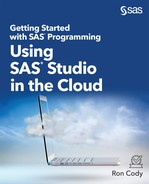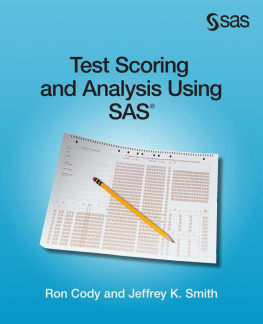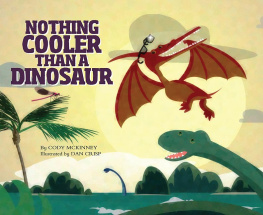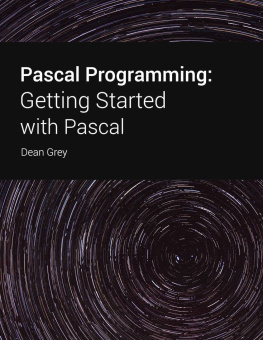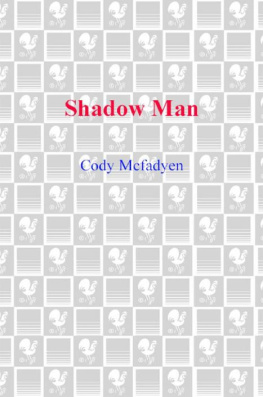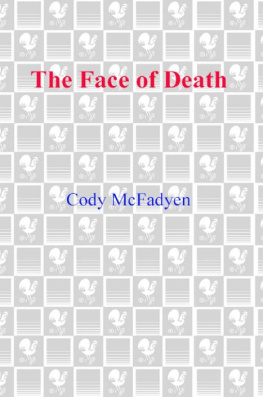Ron Cody - Getting Started with SAS Programming
Here you can read online Ron Cody - Getting Started with SAS Programming full text of the book (entire story) in english for free. Download pdf and epub, get meaning, cover and reviews about this ebook. year: 2021, publisher: SAS Institute, genre: Home and family. Description of the work, (preface) as well as reviews are available. Best literature library LitArk.com created for fans of good reading and offers a wide selection of genres:
Romance novel
Science fiction
Adventure
Detective
Science
History
Home and family
Prose
Art
Politics
Computer
Non-fiction
Religion
Business
Children
Humor
Choose a favorite category and find really read worthwhile books. Enjoy immersion in the world of imagination, feel the emotions of the characters or learn something new for yourself, make an fascinating discovery.
- Book:Getting Started with SAS Programming
- Author:
- Publisher:SAS Institute
- Genre:
- Year:2021
- Rating:4 / 5
- Favourites:Add to favourites
- Your mark:
- 80
- 1
- 2
- 3
- 4
- 5
Getting Started with SAS Programming: summary, description and annotation
We offer to read an annotation, description, summary or preface (depends on what the author of the book "Getting Started with SAS Programming" wrote himself). If you haven't found the necessary information about the book — write in the comments, we will try to find it.
Getting Started with SAS Programming — read online for free the complete book (whole text) full work
Below is the text of the book, divided by pages. System saving the place of the last page read, allows you to conveniently read the book "Getting Started with SAS Programming" online for free, without having to search again every time where you left off. Put a bookmark, and you can go to the page where you finished reading at any time.
Font size:
Interval:
Bookmark:
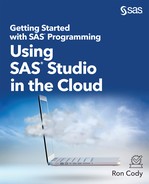
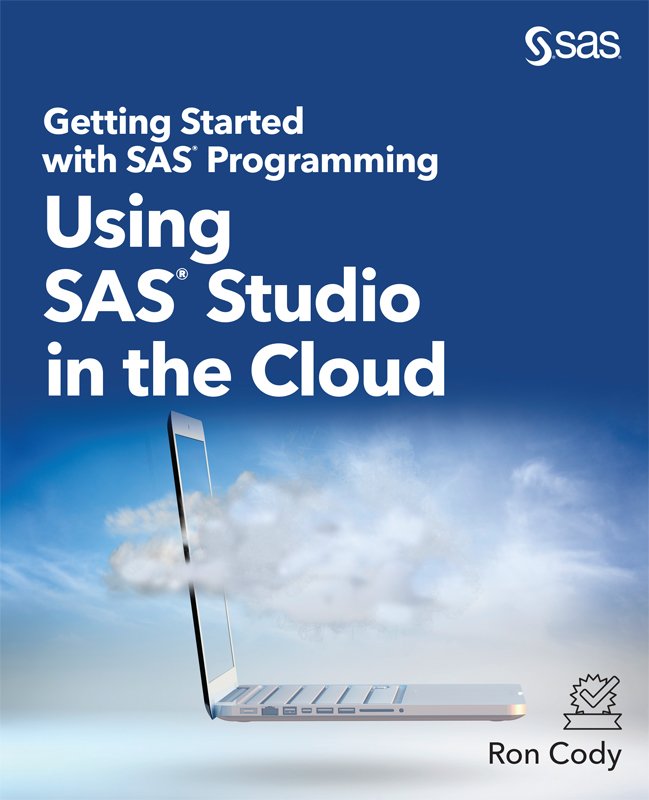
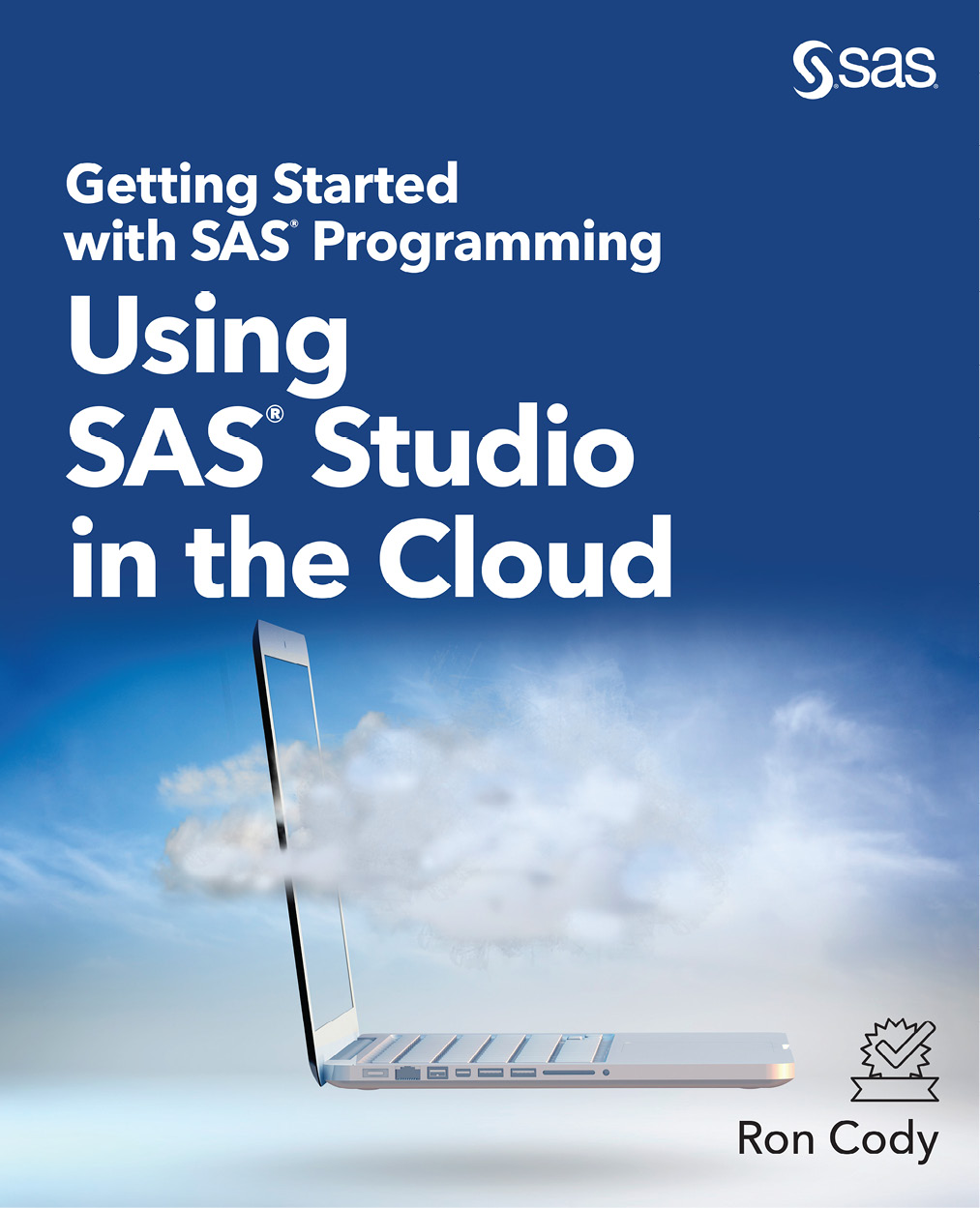
The correct bibliographic citation for this manual is as follows: Cody, Ron. 2021. Getting Started with SAS Programming: Using SAS Studio in the Cloud . Cary, NC: SAS Institute Inc.
Getting Started with SAS Programming: Using SAS Studio in the Cloud
Copyright 2021, SAS Institute Inc., Cary, NC, USA
ISBN 978-1-953329-20-2 (Hardcover)
ISBN 978-1-953329-16-5 (Paperback)
ISBN 978-1-953329-17-2 (Web PDF)
ISBN 978-1-953329-18-9 (EPUB)
ISBN 978-1-953329-19-6 (Kindle)
All Rights Reserved. Produced in the United States of America.
For a hard copy book: No part of this publication may be reproduced, stored in a retrieval system, or transmitted, in any form or by any means, electronic, mechanical, photocopying, or otherwise, without the prior written permission of the publisher, SAS Institute Inc.
For a web download or e-book: Your use of this publication shall be governed by the terms established by the vendor at the time you acquire this publication.
The scanning, uploading, and distribution of this book via the Internet or any other means without the permission of the publisher is illegal and punishable by law. Please purchase only authorized electronic editions and do not participate in or encourage electronic piracy of copyrighted materials. Your support of others rights is appreciated.
U.S. Government License Rights; Restricted Rights: The Software and its documentation is commercial computer software developed at private expense and is provided with RESTRICTED RIGHTS to the United States Government. Use, duplication, or disclosure of the Software by the United States Government is subject to the license terms of this Agreement pursuant to, as applicable, FAR 12.212, DFAR 227.7202-1(a), DFAR 227.7202-3(a), and DFAR 227.7202-4, and, to the extent required under U.S. federal law, the minimum restricted rights as set out in FAR 52.227-19 (DEC 2007). If FAR 52.227-19 is applicable, this provision serves as notice under clause (c) thereof and no other notice is required to be affixed to the Software or documentation. The Governments rights in Software and documentation shall be only those set forth in this Agreement.
SAS Institute Inc., SAS Campus Drive, Cary, NC 27513-2414
February 2021
SAS and all other SAS Institute Inc. product or service names are registered trademarks or trademarks of SAS Institute Inc. in the USA and other countries. indicates USA registration.
Other brand and product names are trademarks of their respective companies.
SAS software may be provided with certain third-party software, including but not limited to open-source software, which is licensed under its applicable third-party software license agreement. For license information about third-party software distributed with SAS software, refer to http://support.sas.com/thirdpartylicenses .
Contents
About This Book
What Does This Book Cover?
This book has two goals: the first is to show readers how to use a free version of SAS called SAS OnDemand for Academics, including how to use point-and-click menus to view, summarize, and analyze data using built-in SAS Studio tasks. The second goal is to teach readers how to program using SAS.
The first part of the book shows readers how to register for SAS OnDemand for Academics. The remaining chapters in this section explore how to use the SAS Studio tasks to inspect, summarize, display, and, finally, how to create graphical representations of data.
The second part of the book is an introduction to SAS programming. Starting from basic concepts, this part of the book discusses conditional logic, looping, SAS functions, and some slightly more advanced topics such as how to analyze longitudinal data and transform SAS data sets.
Although this book covers basic and intermediate topics, more advanced topics such as SAS date interval functions and Perl regular expressions are not covered.
Is This Book for You?
This book is appropriate for beginners as well as intermediate programmers. Even people with advanced SAS programming skills might find this book useful to learn how to use SAS Studio tasks in a cloud-based environment.
What Are the Prerequisites for This Book?
There are essentially no prerequisites for people thinking about buying this book.
Whats New in This Edition?
Parts of this book are similar to an earlier book called An Introduction to SAS University Edition . However, because that book used SAS University Edition while this book uses SAS OnDemand for Academics, it should rightfully be considered a new book and not a second edition of the older book.
What Should You Know about the Examples?
This book includes tutorials for you to follow to gain hands-on experience with SAS. All the programs and data sets used in the text, as well as data used for the end-of-chapter problems, are included in a free download from the SAS author site. Every topic in the programming section is introduced by one or more examples.
Software Used to Develop the Books Content
Every program in the book was written and run using SAS OnDemand for Academics, the SAS cloud-based platform.
Example Code and Data
You can access the example code and data for this book by linking to its author page at https://support.sas.com/cody .
SAS OnDemand for Academics
 This book is compatible with SAS OnDemand for Academics. If you are using SAS OnDemand for Academics, then begin here: https://www.sas.com/en_us/software/on-demand-for-academics.html .
This book is compatible with SAS OnDemand for Academics. If you are using SAS OnDemand for Academics, then begin here: https://www.sas.com/en_us/software/on-demand-for-academics.html .
Where Are the Exercise Solutions?
Solutions to the odd-numbered problems are included at the end of the book as well and in the free download from the author site. Self-learners or instructors can request the solutions to the even-numbered problems by contacting SAS Press.
We Want to Hear from You
SAS Press books are written by SAS Users for SAS Users. We welcome your participation in their development and your feedback on SAS Press books that you are using. Please visit sas.com/books to do the following:
Sign up to review a book
Recommend a topic
Request information on how to become a SAS Press author
Provide feedback on a book
Do you have questions about a SAS Press book that you are reading? Contact the author through .
SAS has many resources to help you find answers and expand your knowledge. If you need additional help, see our list of resources: sas.com/books .
About The Author

Ron Cody, EdD, is a retired professor from the Rutgers Robert Wood Johnson Medical School who now works as a private consultant and national instructor for SAS. A SAS user since 1977, Rons extensive knowledge and innovative style have made him a popular presenter at local, regional, and national SAS conferences. He has authored or co-authored numerous books, such as Learning SAS by Example: A Programmers Guide, Second Edition; A Gentle Introduction to Statistics Using SAS Studio; Codys Data Cleaning Techniques Using SAS, Third Edition; SAS Functions by Example, Second Edition ; and several other books on SAS programming and statistical analysis. During his career at Rutgers Medical School, he authored or co-authored over 100 articles in scientific journals.
Font size:
Interval:
Bookmark:
Similar books «Getting Started with SAS Programming»
Look at similar books to Getting Started with SAS Programming. We have selected literature similar in name and meaning in the hope of providing readers with more options to find new, interesting, not yet read works.
Discussion, reviews of the book Getting Started with SAS Programming and just readers' own opinions. Leave your comments, write what you think about the work, its meaning or the main characters. Specify what exactly you liked and what you didn't like, and why you think so.

